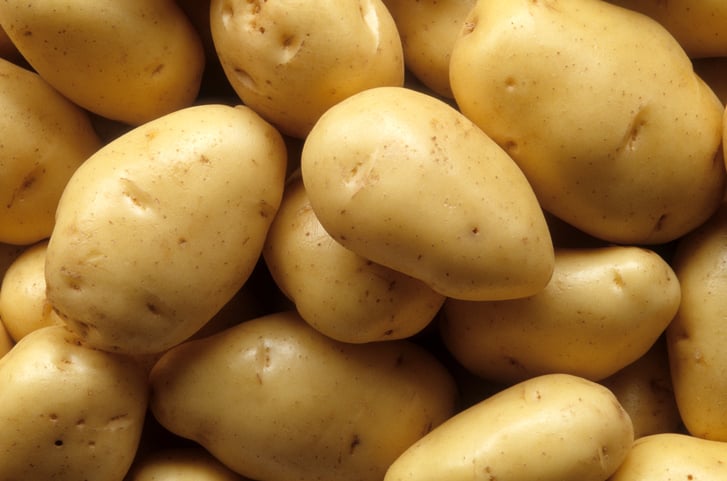Debunking the Myth: Potatoes Are Empty Calories?

Have you been avoiding white potatoes because they’re fattening? Have you been (mis)led to believe potatoes are empty calories? Are potatoes really as bad as you’ve been told? Or, are taters actually a pretty awesome food? A food that many have mistakenly overlooked and eliminated?
Over the past 20+ years, potatoes have received a steady stream of hate mail. They’ve shouldered a mentionable portion of the blame for contributing to obesity and its associated health complications. This has led to the humble spud being demonized. Many people have concluded potatoes are nothing more than empty calories. And because of this, the average potato consumption has dropped by over 40% over the past 40+ years.1 (In hindsight, perhaps that’s clear evidence that we’re ignorant of something our predecessors were quite privy to.)
Let me say this in no uncertain terms: potatoes have been wrongly vilified. In fact, potatoes have been swept under the rug unfairly alongside a category of vegetables scientific experts consider “a forgotten source of nutrients.”2 Here’s why potatoes aren’t as evil as you may have been led to believe.
Nutrient Density
If you say potatoes are empty calories, what you’re saying is that potatoes provide NO nutrients. After all, by definition, the term “empty calories” simply means “calories derived from a food containing no nutrients.” And when it comes to the lowly spud, you couldn’t be more wrong.
Sure, potatoes are rich in carbohydrates, which are often misunderstood and wrongly disparaged as a group. Yet potatoes are also a concentrated source of vitamin C as well as dietary fiber and potassium. And these are nutrients that have routinely been designated as “shortfall nutrients” and “nutrients of concern” in the Dietary Guidelines for Americans. (That is, we don’t get nearly enough of them.)
As far as fiber goes, most people barely get half of what’s recommended. That’s a shame considering that fiber is an all-star nutrient that can beneficially impact blood sugar management, heart health, weight management, and of course, digestive health. Unlike most vegetables, which contain mostly insoluble fiber, potatoes are particularly high in soluble fiber, which is known to lower cholesterol and is associated with less belly fat.2–4
And when it comes to potassium, which plays key roles in heart, bone, and kidney health, most people are drastically undernourished. In fact, only about 2 – 3% of Americans get enough. Guess what? Per serving, potatoes contain more potassium than any other vegetable. Heck, a potato contains more potassium than a banana—more than three times more, in fact (with 1,553 mg to 422 mg).
There’s even more to potatoes, as they contain appreciable amounts of magnesium, phosphorus, iron, zinc, and vitamin B6.
If you still think potatoes are empty calories, the counterargument isn’t yet complete. Oh, and speaking of which, potatoes contain high-quality, complete protein. Granted, potatoes aren’t a great source of protein by any means. However, the protein quality of potatoes is higher than that of any other regularly consumed plant protein (e.g., legumes). In fact, the quality (in terms of digestibility and amino acid content) of protein in potatoes rivals that of eggs, which is often regarded as a “gold standard” protein source.2
And despite their white color, potatoes are rich in phytochemicals, many of which function as antioxidants. For example, potatoes contain substantial amounts of phenolics, including flavonoids (quercetin and kaempferol), phenolic acids (gallic acid, chlorogenic acid, and caffeic acid), which help fight free radicals and manage oxidative stress among other health benefits.5, 6 In fact, many would argue that it’s in the phytonutrient content of fruits and vegetables where their “superpowers” lie.
With all that in mind, it’s no wonder that populations (e.g., civilizations in the Andes) have not only survived but thrived on potatoes alone, but there’s still more…
Resistant Starch
While potatoes contain a variety of key nutrients, one that really stands out is resistant starch, which is a very unique type of carbohydrate that we’ve talked about extensively. Without getting too thick into the weeds, here’s a laundry list of benefits associated with resistant starch, which is aptly named because it “escapes” digestion:6
- Increases metabolic rate and energy expenditure
- Reduces the caloric density of food
- Decreases the glycemic response to a meal
- Reduces the insulin response to a meal
- Improves insulin sensitivity
- Increases satiety or satisfaction
- Reduces hunger
- Decreases food intake
- Increases fat burning
- Decreases fat storage
- Preserves calorie-burning muscle mass
- Promotes weight loss
- Enhances laxation
- Increases the uptake of minerals (e.g., calcium)
Another perk of resistant starch is that it acts as a “prebiotic” fiber. Because it’s not digested in the small intestine, it passes along to the colon where it is fermented by gut bacteria. That’s a good thing—a really good thing. For instance, one of the byproducts of this fermentation process (i.e., butyrate) helps promote a healthy inflammatory response and supports a healthy intestinal lining. And get this, it stimulates the release of appetite-crushing hormones.
Raw potatoes are naturally high in amylose, which is a “resistant” starch. Cooking, however, increases the digestibility of the starch. In other words, cooked potatoes are much lower in resistant starch than raw potatoes. Get this, though. Cooked potatoes that have been cooled once again increases the resistant starch content of potatoes.
Still stuck in the mindset that potatoes are empty calories? Well, there’s even a bit more ammo in the spud gun.
Satiety
Even though potatoes are often considered a high-calorie food, they provide less than 1 calorie per gram (by weight). This makes them a low-energy-dense food (LEDF). Of course, there are preparation methods that dramatically increase the energy density of potatoes (ahem, French fries), which we’ll get into momentarily.
For now, what you need to know is that when you eat more LEDF (other examples include fruits and vegetables), you can enjoy more food (volume) with fewer calories. That’s key because one of the most important factors in making you feel full and satisfied (i.e., satiety) and cueing you to stop eating is food volume. Diets high in LEDF typically result in greater satiety and lower caloric intake.4, 6,7, 8
Speaking of satiety, which some have referred to as the “new diet weapon” or “the fullness factor,” Dr. Susanna Holt and her colleagues conducted a study where they determined the “satiety index” of 38 common foods, including potatoes, a variety of fruits, several high-protein foods, oatmeal, rice, pasta, breakfast cereals, and more. Boiled potatoes blew the competition out of the water, scoring 44% higher on the satiety index than any other food!8
Having said all that, most of you know that potatoes are rarely eaten by themselves…
Preparation Methods
So, let’s talk about the ol’ elephant in the room: preparation. This can certainly be an explanation for the notion that potatoes are empty calories. According to the United States Department of Agriculture, OVER HALF of the “potatoes” consumed by the average person come in the form of French fries and potato chips.
And if I had to guess, of the remaining portion that’s made up of “fresh,” unprocessed, whole potatoes, I’d speculate that a pretty hefty chunk of that is eaten as loaded or twice baked potatoes, mashed potatoes, hash browns, potatoes au gratin, scalloped potatoes… I think you get my point.
Most people’s ideas of potatoes are a far cry from just the humble ol’ spud. And that, my friend, is a big reason why many have been misled to believe potatoes are empty calories.
For instance, a plain baked potato contains 100 calories while a “loaded” baked potato contains at least FOUR TIMES that many calories. And, that’s probably a gross underestimate given that most restaurant-style potatoes are the size of your head. Meanwhile, an equivalent portion of potato chips packs nearly SIX TIMES as many calories as a plain spud. I think you can see where I’m going with this.

Glycemic Index
Besides being deep-fried and slathered with cheese, sour cream, mayo, ketchup, and other calorie-dense additives, another argument that potatoes are empty calories hinges on their glycemic index (GI). The GI refers to a food’s effect on blood sugar levels. While potatoes are commonly considered a high GI food, a distinction that’s often associated with poor health outcomes, there are several problems with this scapegoat:
- The GI ignores nutrient and energy density. In the case of the former, potatoes have a high nutrient density and low energy density, which are both highly desirable. Contrast that with sugar, for instance, which has a low nutrient density and high energy density (a good example of “empty calories”).
- The GI is based on consumption of a single food in isolation, not as part of a mixed meal. I don’t know many people who eat potatoes (routinely) by themselves. They’re usually part of a meal that includes other foods providing some protein, fat, and even fiber, which can all reduce the GI of a meal.
- The GI is calculated based on consuming 50 grams of carbohydrate from potatoes, which is roughly equivalent to two baking potatoes. That’s a lot of potatoes. And, remember, potatoes are quite filling by themselves, let alone as part of a mixed meal. In other words, it’s not that common for folks to consume a similar amount of REAL potatoes in one sitting.
- Even if the GI of individual foods did matter, there is tremendous variation in the GI values of potatoes, depending on the cultivar and preparation. For instance, raw and cold potatoes have lower GI scores (presumably due to their resistant starch content).
Finally, if you don’t want to take my word for it, then maybe you’ll believe a review study where researchers scrutinized the GI issue with potatoes by pointing out that taters:1
- Have a high nutrient-to-energy density ratio (fundamentally disproving that potatoes are empty calories).
- Are low in energy density compared to other carbohydrate sources.
- Contribute to early satiation (feeling fuller sooner).
- Lower food/caloric intake.
In other words, the researchers concluded that, when applied to potatoes, relying on the GI leads to premature and possibly counterproductive dietary advice. I agree.
Supercharge Your Diet Results with IC-5
IC-5, which is scientifically-designed to promote insulin sensitivity and improved carb tolerance, is one of our top diet-boosting supplement.
With IC-5, you know that you are supporting carbohydrate tolerance, keeping potentially harmful AGEs at bay, and amplifying the anti-aging effects of the ketogenic diet. It’s a triple threat for overall health and anti-aging!
Potatoes Are Empty Calories? The Take-Home Points:
- Simply put, it’s nonsensical to say potatoes are empty calories, which means “calories derived from a food containing no nutrients.” You can make an argument for sugar providing empty calories but NOT potatoes.
- In fact, a panel of scientific experts convened by Purdue University delegated potatoes as “a forgotten source of nutrients.”
- Potatoes have a high nutrient density and low energy density.
- Among their many nutrients, potatoes provide significant amounts of potassium and fiber, two common nutrient deficiencies with key health benefits.
- Raw potatoes and potatoes that have been cooked and then cooled contain significant amounts of resistant starch, which is associated with a laundry list of benefits.
- Even though they’re not a great source, potatoes are one of the best plant-based sources of high-quality protein.
- Have you eaten any REAL potatoes lately? If so, you know they are incredibly filling and satisfying. In fact, researchers have shown they have the highest satiety value of any food tested.
- If you think potatoes are empty calories because they have a high glycemic index, it’s time to re-think your position. The GI is virtually meaningless, particularly when it comes to potatoes.
- All that said, potatoes can be a vehicle for excess calories; however, the position that potatoes are empty calories is fundamentally wrong.







